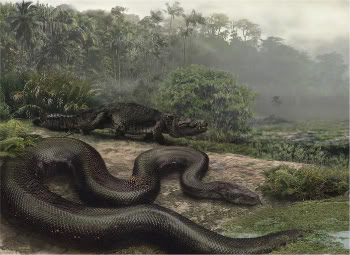|
|
In a paper published in Nature scientists announced the discovery of the world’s largest snake, a prehistoric beast which preyed on giant turtles and crocodile-like reptiles in South America after the demise of the dinosaurs. As amazing as the discovery is, its greatest importance may be the clues it provides conservationists about the future of tropical forests under various global warming scenarios.
“At its greatest width, the snake would have come up to about your hips,” David Polly said, Indiana University Bloomington geologist. “The size is pretty amazing. But our team went a step further and asked, how warm would the Earth have to be to support a body of this size?”
Polly’s question was important for several reasons. First, fossils in tropical forests are extremely rare due to the lack of bare rock: the snake, christened titanoboa, was found in a coal mine. It is one of the very few fossils from that period in South America.
 This artist’s rendering of Titanoboa cerrejonensis demonstrates the great snake’s size. It is anticipated the boa spent much of its life in or near water. Picture by:Jason Bourque, University of Florida. |
“Until now, tropical South America’s dense forest prevented discovery of fossil vertebrates found between 55 and 65 million years ago, so this discovery gives us a very unique and important glimpse into the past,” Jonathan Bloch said, a vertebrate paleontologist who helped lead the expedition.
Secondly, using the measurements of the titanoboa, the scientists were able to draw conclusions about the environment in South America 60 million years ago. Cold-blooded animals, like snakes, are limited in body size by the average temperatures of where they live. The hotter the ecosystem, the larger a reptile could grow.
“If you look at cold-blooded animals and their distribution on the planet today, the large ones are in the tropics, where it’s hottest, and they become smaller the farther away they are from the equator,” Bloch said.
Considering the titanoboa was twice the size of today’s largest snake, the anaconda, the scientists estimated that the average temperature of its ecosystem would have been about 91 degrees Fahrenheit, 10 degrees warmer than the tropical forests which cover South America today.
“This temperature estimate is much hotter than modern temperatures in tropical rainforests anywhere in the world,” said Carlos Jaramillo, a paleobotanist at the Smithsonian Tropical Research Institute. “The fossil floras that the Smithsonian has been collecting in Cerrejon for many years indicate that the area was a tropical rainforest. That means that tropical rainforests could exist at temperatures 3-4 degrees Celsius hotter than modern tropical rainforests experience.”
Such a discovery may have widespread implications as scientist attempt to predict how tropical forests will change in face of global warming. Many have feared the forest would become savannah due to higher temperatures, but if the climate of 60 million years ago is any indication some of tropical plants could survive temperature increases.
“These data challenge the view that tropical vegetation lives near its climatic optimum, and it has profound implications in understanding the effect of current global warming on tropical plants,” Jaramillo said.
At a symposium last month preeminent tropical biologist, Joseph Wright, said that he believed climate change was the gravest threat to tropical forest. He warned that global warming would create a “novel environment” in the tropics, adding that scientists “have no way to predict what it will look like”.
The discovery of the long-extinct colossal snake may be the beginning of accurate predictions.
For more information on the finding of titanoboa: World’s largest snake discovered: prehistoric serpent was twice the size of an anaconda
Related articles
What is the greatest threat to rainforests: habitat destruction or climate change?
(01/13/2009)
A symposium hosted by the Smithsonian Institution set to debate the threat level posed by deforestation to rainforests, shifted topic slightly near its end as scientists discussed which is the most significant threat to tropical forests and their species: habitat destruction or climate change?
Past climate change may have fried rainforests
(02/18/2007)
Three hundred million years ago, Earth’s climate shifted dramatically from icehouse to hothouse, with major environmental consequences. That shift was the result of both rising atmospheric carbon dioxide concentrations and the melting of vast ice sheets, new research by University of Michigan paleoclimatologist Christopher Poulsen shows.